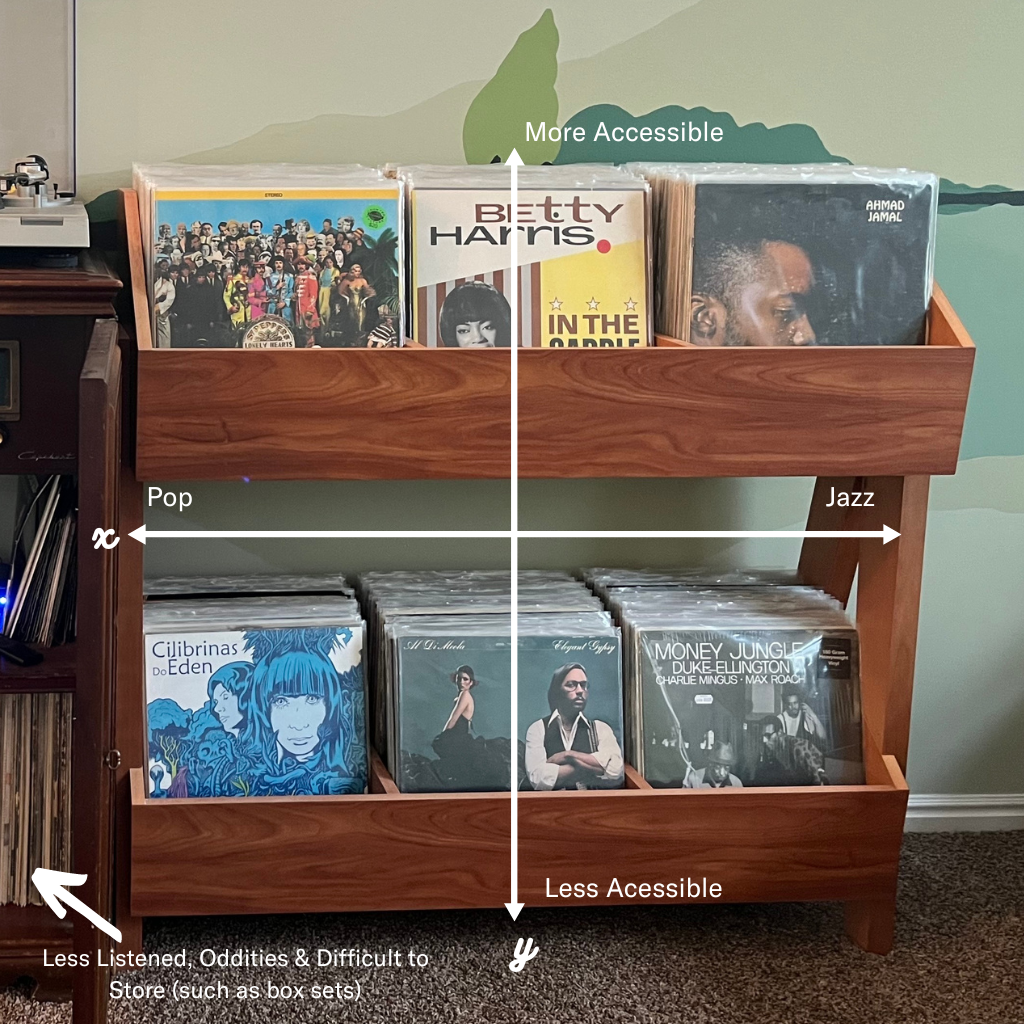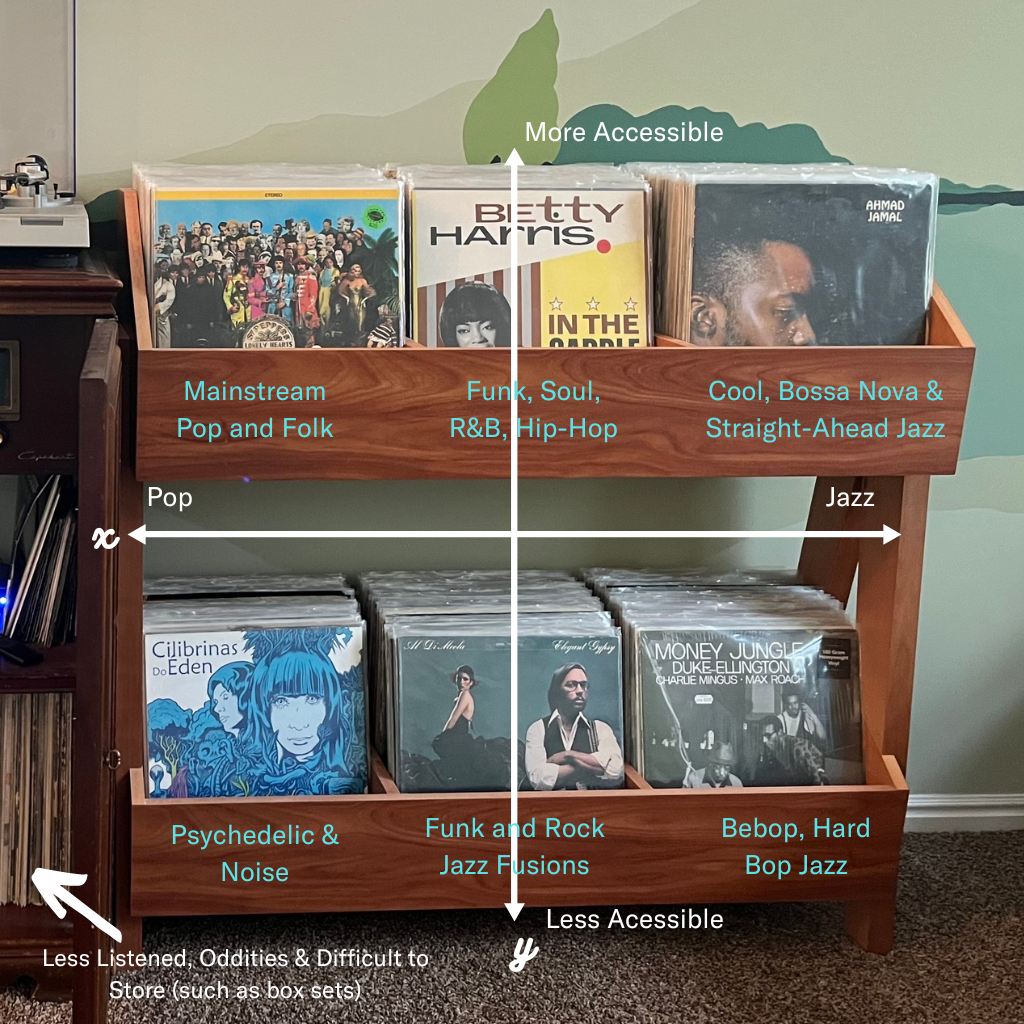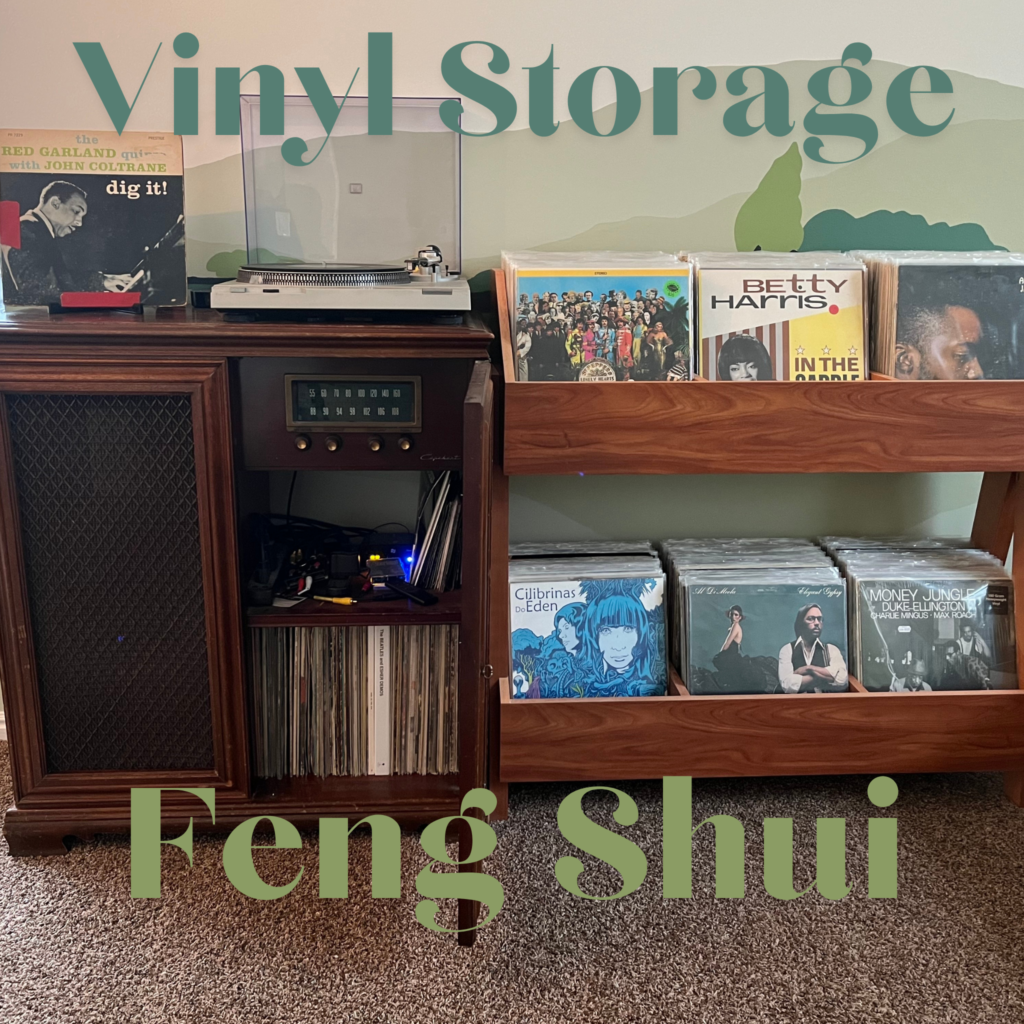If you store your vinyl purely in alphabetical order with no other guiding principals, you may begin to feel like it’s difficult to browse your own collection in a meaningful way at a certain point. I don’t know very many people who like an artist or band because of the first letter in its name, and so pure alphabetical order probably doesn’t make sense as our only guiding principle, assuming we browse based on the mood we’re in and not how the artist spells their name.
For me that threshold where pure alphabetical order didn’t make sense was at around 150-200 records. Now that my collection is nearing 400 and continually growing, I decided to spend my labor day weekend devising a better way to let my collection “flow.” I know that I have a puny collection compared to many that are reading this right now, and I imagine that many great minds have attempted to solve the conundrum of browse-flow vs alphabetical purity. Below is how I’ve begun to tackle the problem.
What does Feng Shui have to do with vinyl record collecting?
The term “Feng Shui” which literally means “wind-water” in Chinese, gets tossed around in interior decorating circles frequently (and now allow me to toss it around, but hear me out). The idea is that you want to arrange your living space to be in harmony with nature. It’s called wind-water because those are the two forces in ancient Chinese thinking that were constantly moving, and it’s believed that invisible energy constantly flows through our living spaces in the same way, and that we must arrange our living space to go with the grain of those forces.
Hence, arranging physical collections such as vinyl records can also benefit from strategic arrangement to mimic nature, or more specifically, our natural flow of accessing and browsing our collections.

Creating Browsing Vectors
As with Feng Shui, which relies on understanding the direction, that energy naturally flows, my theory of vinyl record storage is more about arranging the collection in a way that exploits the natural grain of how my brain works, looking at connections that exist along certain spectrums in my mind. Doing so between the different areas of my collection creates something similar to a 2-dimensional graph in physical space, where there’s an X and a Y axis. The third dimension (Z – from front to back) of each section is for alphabetical order in ascending order (A in front).
A quick word about Vinyl Storage furniture. As you’ve already noticed, I’m talking about arranging my collection according to a specific piece of media collection furniture. We all have different options, from the popular and highly affordable Kallax (Ikea) to fancier options. I know that after my collection passes about 450 I’ll need to add more storage. There are ways to create flow no matter what furniture you’re using — the idea is to arrange the physical collection to jive with the grain of your brain.
The first step therefore is to decide what your 2 browsing vectors are – what are the X and Y Axis describing? As an example, for me personally, I’m usually feeling my way through these 2 spectrums:
- The Rock/Folk/Pop Extremes <—> The Jazz Extremes (with Fusions, Funk, R&B, Hip-Hop, Soul, etc. in between)
- Easier Accessibility (Easier Listening) <—> More Difficult to Access (Complex, Noise, Less-Lyrical)
The Y Axis’s purpose for me has a lot to do with having company over. Listening to vinyl is an immensely social practice, and the larger/more mixed the audience, the more accessible the music should be for more people to enjoy. Putting the accessible records on the top row makes browsing easier for guests
I assume that many people may think of browsing vectors in a similar way, but how we choose the anchors of our spectrums or interpret our collection’s spot on those spectrums is personal, like a fingerprint. The breadth and depth of our personal definitions vary greatly from one person to another, as well as the anchors they use to determine the ‘extremes’. The only goal is to arrange the vectors in a way that makes the most sense to you, and it’s something you might constantly change little by little as your own opinions and senses change. The only right answer is the one that puts your collection in the flow or grain of how your brain browses.

Interpret Your Collection Along Your Vectors
After I decided on these vectors, the next task was to divide up my collection using genre. Since I use discogs.com to catalog my collection (See my Discogs collection here), I have my collection stored in folders on the Discogs platform that allow me to draw my own lines in terms of genre – something that I find very key to browsing my quickly-growing collection.
For those unfamiliar with Discogs, it’s the central location where physical media collectors go to understand exactly what they have in their possession. It’s also a great way to show others your collection (especially if they want to gift-shop for you but don’t know what you already own). In that sense it functions similarly to social media where you can be ‘friends’ with other collectors and watch collections grow.
Discogs is of course much more than that, it’s also a marketplace where people sell physical media all over the globe, and in addition they are a media company themselves, publishing content about music and music culture.

Where I went to export my Discogs collection into a CSV which I could then play with using Excel Pivot Tables.
Discogs allows you to export your collection in a CSV. For people with REALLY large collections I imagine this is quite valuable. I used this function to put the data into an Excel Pivot Table and look at how many records would be in each bin based on different interpretations of my collection. Part of Feng Shui is (I’m guessing) being able to comfortably flow through a physical space, and so having the right amount of vinyl in each bin should factor into the equation in my opinion.
The result of the Excel Sheet experimentation did not get me to the exact state that my collection is in, but it helped model some ideas to get a feel for how many records would be in each bin as I lumped sub-genres together and split them apart in my pivot-table.
Be Flexible as You Populate the Bins
After getting a good feel for how the genres would be divided up and placed in the bins, I went to work placing my records in the correct bins. I did not follow the Excel sheets in this process. I began doing so and found it to be a mismatch for the task. The idea I believe is to first strategize the genres carefully using something like Excel (to reduce the amount of record-moving you have to do), but to let your subconscious do the rest as you make decisions on each record. You can always make changes later, just let it flow!
I arranged the records in alphabetical order in each bin by artist/group in ascending order. I also allowed artists/groups who have mastered multiple genres to occupy multiple bins since keeping all of an artist’s records together for me personally is a low priority. A good example is Miles Davis who occupies 3 bins: funk fusion, hard bop and cool jazz.
As time goes on and as our opinions/tastes change, so should the placement of our records. After all, feng shui, as far as I understand it, is a vector, not a static state, meaning that it’s always moving in one direction or another.




